Remote work is no longer a choice or privilege for most of us. The global health crisis proved to be a catalyst for the swift adoption of remote work worldwide.
88% of organizations have encouraged or required their employees to work from home, and 74% of companies plan to shift to remote work post-COVID permanently according to a study by Owllabs.
And as we get accustomed to working remotely, we also need to start laying solid groundwork to work remotely in the future. While recruitment is one job that cannot do away with human touch completely, technology can enhance and automate recruitment processes and enable enterprises to hire candidates not only completely remotely but also significantly faster.
Recruiters now need to innovate and reinvent recruitment processes and start paving the way to the future of recruitment: Remote Hiring.
This blog post is a complete guide on Remote Hiring and how to get started on hiring remotely and covers:
1. What is remote hiring? Why remote hiring?
2. Benefits of Remote Hiring Process:
3. How to Get Started with Hiring Remotely:
What is Remote Hiring?
Remote hiring or remote recruitment is the process of sourcing, assessing, shortlisting, and selecting candidates through online or remote methods such as automated sourcing and screening, online assessments, video interviews, behavioral tests, and more using a remote hiring software.
Remote recruitment is not a new concept. Many large organizations already use remote recruitment technology in some aspects of hiring if not all. Sourcing candidates through online job portals, online ads, and social media is becoming a popular practice among recruiters from enterprises globally
But remote hiring does not include just that. It means doing every single process through online means. And many enterprises have realized the huge asset technology can be in recruitment.
Remote hiring has proved to be one of the most efficient ways of hiring suitable candidates. Not only is it the most upcoming, relevant, and obvious next step in upgrading recruitment processes, it also has many benefits (discussed later in the blog post) that organizations tend to overlook as they want to stick to traditional methods of hiring that they are already familiar with.
To understand better, let’s take the example of the remote hiring solution by Talview. Talview employs its Instahiring Experience platform to enable its customers to create a fast and friendly hiring process. The Instahiring platform employs the RAR technique which stands for Remote, Automate, and Reuse. It allows you to hire faster and better by:
- Enabling anytime-anywhere hiring
- Automating routine recruiting tasks
- Capturing & Reusing candidate data across the hiring process
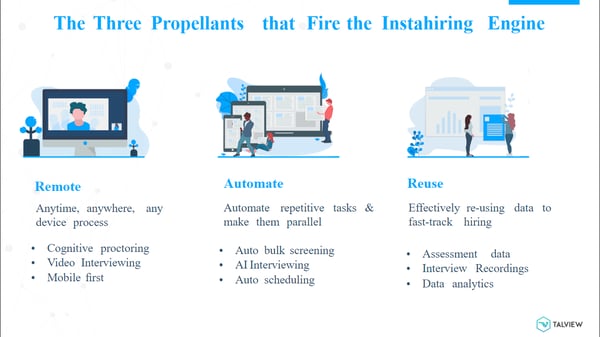
These are the three pillars of hiring high-quality candidates without wasting time on mundane and repetitive recruiting tasks.
To learn about the Instahiring experience platform in detail, read this blog post.
Benefits of Having a Remote Hiring Process
Let’s talk about the five main benefits of remote recruitment for recruiters and their organizations.
1. Reduced Time to Hire
The single most important metric to track the success of your hiring process is Time to Hire. Fast-paced businesses always require immediate hires and if you don’t have a wide enough talent pool at hand, you might end up wasting a lot of resources and time on finding the appropriate talent. This eventually leads to organizations spending way more on hiring than they should.
Good candidates only stay in the market for an average of 10 days. And if your hiring process takes up to 30-40 days, chances are, you are missing out on high-quality candidates because of your high time to hire.
One of our clients, HCL America, was spending a huge amount of time screening and scheduling candidates while they ended up selecting only a handful of them. They were looking for a more efficient, resource-friendly solution to their hiring workflow when they came to us. Talview helped them to automate their screening process by replacing it with recorded interviews and then a final round of interview.
Because of remote interviews only, HCL America was able to assess 1200+ candidates in a span of 6 months with just a team of 2 evaluators. In short, Talview helped the evaluators save 200 hours of panel time. This is what Mohanasundaram Rajamanickam, Group Project Manager at HCL America Inc. had to say about his experience,
“A lot of times it was difficult to coordinate time to schedule interviews with so many candidates. Talview’s Asynchronous Video Interviews gives us the flexibility to screen candidates at our own time, as well as allocate tasks within the team. The success rate of the conversions with Talview has been good, and Talview has been a great help for the team here.”
Read the full case study: HCL America Inc Saves 67% Panel Time with Talview’s AI-Powered Video Interviewing Platform
Also, given the increasing number of mobile-first millennial and Gen-Z candidates taking over the global workforce, they would not settle for an organization that is not yet digital or those that practice age-old methods in the age of Uber and Amazon. Reducing your time to hire through technology and automation can set you apart from the archaic recruitment processes of your competitors.
Hiring remotely through a recruitment automation software can help you significantly reduce your time to hire by enabling you to screen, assess, and interview candidates all in one place.

2. Reduced Cost Per Hire
It costs an average of USD 4000 for every new hire, according to Investopedia. And the cost only increases with the time you spend. Hiring candidates remotely means sourcing them through job portals or your website’s career’s page, screening them through ATSs or advanced screening tools, assessing them with the help of online assessments or assessment software, and interviewing them through remote video interviewing software or platforms.
With how far technology has come today, there are tools and services in the market that enable you to do all of the above with a single platform. Having one single remote hiring software or tool that can take care of everything that recruiters do manually can speed up the entire process.
Imagine the productive time that the recruiters can save to draft better job descriptions (if not already) or create more effective interview questions/panels to get the best talent for the role.
Not just that, instead of spending on multiple software for multiple jobs to be done, you just have to find the right software that does everything for you. That can save you money from buying an unnecessary number of software as well as save you other unseen money and resources spent on finding talent manually.
You can find such recruitment tools that meet your criteria, fit your recruitment process well, and also fall within your budget. For instance, Talview helped a management consulting firm, ZS Associates, to significantly reduce the operational costs of their campus fairs with the help of remote assessments and interviews.
3. Improved Candidate Experience
As mentioned earlier, the workforce ecosystem is undergoing a massive transformation with digitally native Millennials and Gen Z’s entering the space. Statistics show that Millennials will constitute almost 75% of the working demographic in the United States by 2030.
This new bunch of working millennials and Gen Z’s have grown up with technology around them for at least their formative years. Being so used to leveraging technology for performing even daily tasks, they would not want to work in an organization that has long hours of manual hustling for processes that can be automated.
The emerging workforce wants to work for someone that is like them, someone who is tech-savvy. If your hiring process extends beyond a week and requires your candidates to fill our papers and get on multiple calls and email threads, chances are that the candidate will drop out and opt for a company with a better and more candidate-friendly hiring process.
If you can order a fresh meal or book a cab on your mobile with the tap of a finger, then these digital natives want that for recruitment too.
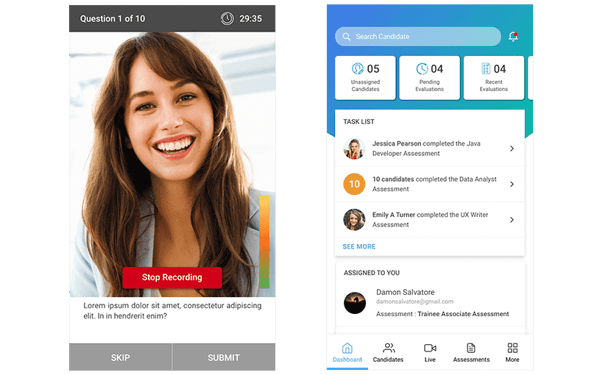
Mobile view of a candidate's video interview and mobile screen of a recruiter on Talview's Recruiter App
A study found that 60% of candidates quit an application process because it took too long. Having a digital and mobile process saves both your and your candidates’ precious time; and they will respect that. Providing your candidate with a great hiring experience will also help in improving your brand image and make you stand out among your competitors.
4. Reuse Old Data
You might be familiar with how an ATS works. You post about a job opening, you get applications, they get stored in your ATS, it filters out the resumes that qualify for the role, and the ones that don’t qualify become history.
While this was the best we could do until a few years ago, the technology boom has opened up a wide arena of opportunities for efficient hiring. All the candidates that did not reach the benchmark for a particular role at a particular time could over time build a wide talent pool that can come handy anytime you need to hire for a quick position.
There are recruitment tools that leverage Artificial Intelligence and Machine Learning today that enable its users to not just store candidate data, but also reuse it at a later time if required.
Talview’s Instahiring Experience platform does exactly this. It is a comprehensive end-to-end platform that not just helps you sift through a wide range of applications to choose the most appropriate resume, but also stores the rest of the candidate resumes or assessment results who didn’t quite meet the requirement.
It pushes a trigger to the user when they add a new requirement on the platform if the database already has a candidate profile that would fit the role. This enables recruiters to conserve time and energy on searching for candidates from scratch every time a new vacancy arises.
5. Improved Recruiter’s Productivity
A study conducted by Linkedin revealed how remote work leads to higher levels of productivity. Although multiple reasons contribute to it, we can deduce how working remotely can help improve recruiters’ productivity. This goes hand in hand with the automation of recruitment processes.
Recruiters spend the majority of their time checking every job portal for a fit candidate, calling hundreds of prospects sometimes, screening their resumes, checking attempted pre-recruitment assessments, coordinating with panel/hiring manager’s and candidates to find the best time to schedule interviews.
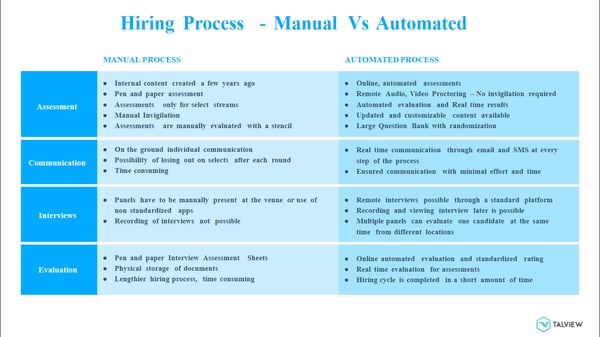
If organizations invest in recruitment software to automate scheduling and other recruitment processes that would leave the recruiter with abundant time to coordinate better with teams to learn about the vacant position with better insights, attract a more streamlined and appropriate candidate pool, create engaging relationships with potential candidates, have a more efficient interview system in place, organize data-driven hiring, etc., in turn, improving the overall efficiency of the organization.
How to Get Started with Hiring Remotely
With all the benefits mentioned above, it's time to now equip you to start your remote recruitment journey. Here are the essential remote hiring best practices and tips to help you start hiring the talent you need from anywhere in the world.
1. Candidate Sourcing
The first task that recruiters can start performing remotely is sourcing. One of the easiest methods is to have a recruitment chatbot on your website’s career’s page. You can have a third-party chatbot installed on your career’s page.
That way, interested candidates who visit your website will be able to easily send you their resumes by answering a few preliminary questions right from your website. You can be sure of never losing any potential candidate that might be interested in working with you.
If the candidate qualifies, a chatbot can even begin the recruitment process of a candidate by automatically sending them a pre-recruitment assessment for the position they applied for.
Not just that, with the application process so easy, you can also push many passive candidates to apply to work with you if they are merely lurking on your website.
2. Automated Screening
Instead of skimming through hundreds of profiles manually, carefully looking for the right skills and experience, you can simply employ a screening tool for the job. A screening tool or software allows you to feed in your job requirement for a particular role.
Once you feed in your requirements, the tool only allows the candidates with the required skills to pass through. This step becomes critical when you don’t want undeserving candidates to qualify because of the recruiter’s subconscious bias.
A screening tool can also standardize the kind of talent that goes through the interview rounds. This ensures benchmarking of skills that you are looking for the role and makes sure that only high standard candidates meet you for the interview round.
3. Automated Workflows
One of the most convenient tools for recruiters would be the one that has automated workflows in place. Automated workflows simply automate certain smaller but important steps in the recruitment process that the recruiter has to do.
.png?width=600&name=Screenshot%20(1735).png)
Talview’s automated multi-section workflow
Be it an email to the candidate after assessment completion, an invitation for the next round, interview scheduling, tracking and following up using scheduled reminders, sharing panel reminders for interviews, and more, you can create automated workflows for any task to ease your workload.
These are obvious but small tasks that compound as the number of assessed candidates increases. Having automated workflows as a part of your remote recruitment software can save you the time and resources you never thought you could save before.
Moreover, you can also create elaborate recruitment workflows that help you automate the entire hiring process with zero to minimal human intervention: right from inviting candidate applications through a chatbot to providing them pre-set assessments and on-demand video interviews as they qualify. You need not intervene till the candidate qualifies all the rounds and needs to be handed the offer letter.
4. Skills and Behavioral Assessment
You already might be familiar with many online assessment tools that help organizations hold pre-recruitment assessments for candidates. These tools usually have a variety of assessments such as MCQ, Essay, Coding, Typing, Aptitude, Behavioral, Personality, and more for a variety of roles and are extremely accurate in finding the perfect candidate, if used correctly.
To ensure the authenticity of the results, such online assessments have proctors or invigilators looking through the candidate’s video and audio feed while the candidate attempts the test. This can be done either live or by pre-recording assessments that are reviewed by professional proctors at a later time.
To learn more about remote proctored assessments, click here.
Assessment tools are also highly useful when hiring for bulk roles. Some of these tools even provide you with a report of all candidate performances after they have attempted the online exam.

An example of one such tool is Talview’s Behavioral Insights or TBI. It is the world's first job competency measurement tool that uses psycholinguistics to create a behavioral profile of candidates. TBI categorizes skills according to every role into Critical, Essential, and Desirable and assesses candidates on the basis of those skills.
Talview also offers a Learnability Index (LI) along with behavioral assessment reports. Talview’s LI can help you identify candidates who have the highest potential to learn and grow professionally.
Such mechanisms play a huge role in cutting down the risk of a bad hire and increasing the chances of your organization, as a whole, to out-perform its competitors in the long run.
5. Video Interviewing
Let’s start by addressing one thing: By video interviewing tools, we do not mean your usual video call applications. Platforms like Zoom or Skype are not recruitment or interviewing tools and do not suffice the need for a platform that has features and capabilities that enhance your interview-giving and taking experience.
Remote hiring software
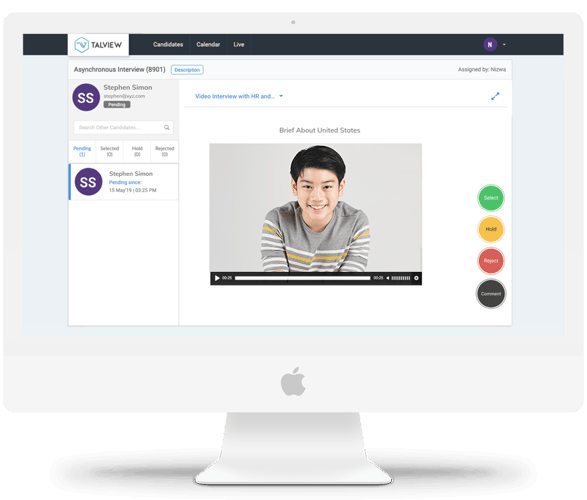
A candidate taking an asynchronous video interview on Talview platform
An interviewing tool gives you the freedom to hold recorded or live interviews as per your and your candidate’s convenience. While a live interview is just like a face-to-face interview, in a recorded interview, the recruiter or hiring manager has to record their questions one by one and upload it on the interviewing platform to share it with the candidates.
These questions recorded once can be used for multiple candidates being hired for the same role. This saves hours of panel time spent in coordinating and does away with multiple screening rounds to allow you to see more candidates in less time.
Conclusion
The adoption of Remote Hiring technology has started gaining momentum, given the current scenario. But what started as a necessity can be turned into your weapon to transform your hiring process and help you strategize in ways you never thought of before.
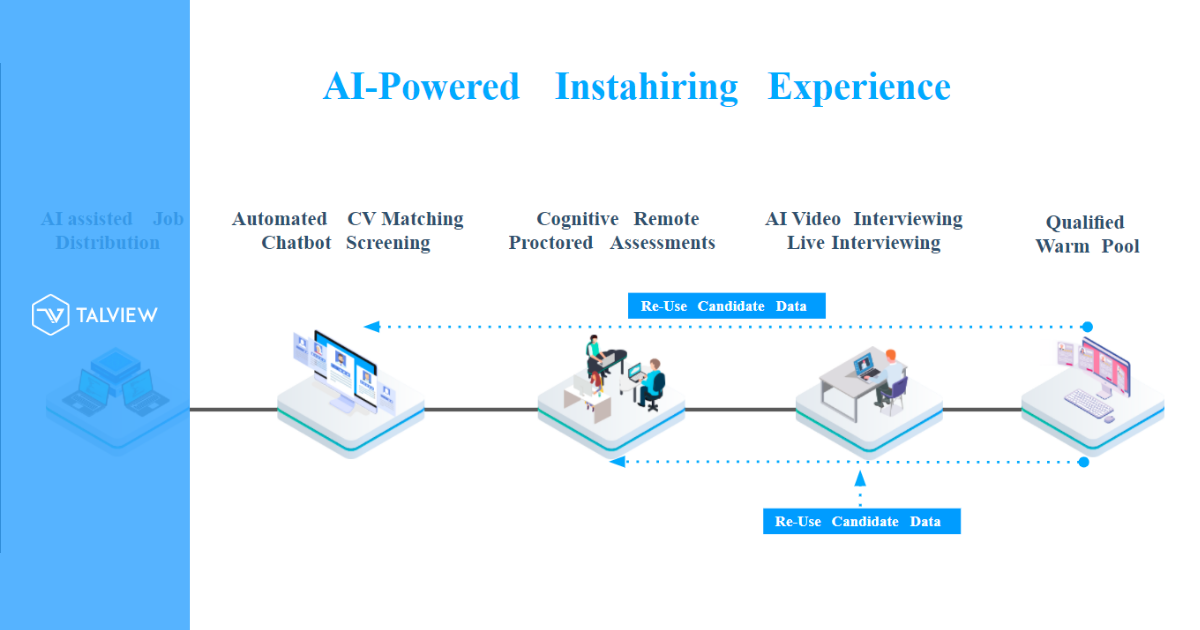
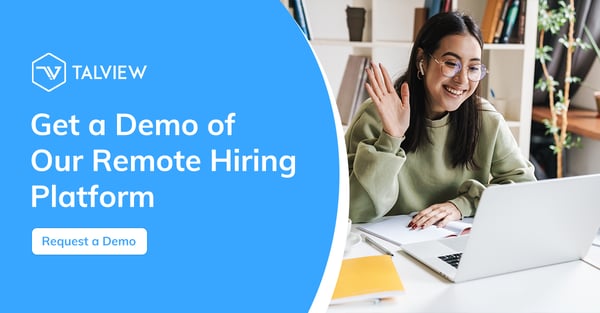


Leave a Reply